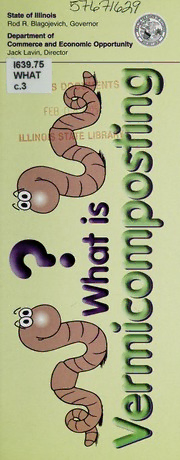
What is vermicomposting? PDF
Preview What is vermicomposting?
6IrlSHbtff State of Illinois Rod R. Blagojevich, Governor Department of Commerce and Economic Opportunity Jack Lavin, Director What is vermicomposting? Vermi is the Latin word for worm and composting is the process of turning organic waste into nutrient rich soil. Therefore, vermicomposting is the process of converting organic waste into nutritive humus using worms. The worms are kept in an enclosed container (called a worm bin, see picture at right) where they are fed kitchen scraps and table food waste. The worms used for vermicomposting are commonly called red wigglers, redworms or manure worms, but the exact species is Eisenia foetida. One pound of red wig¬ glers will consume a half pound of food per day. These worms are known as sur¬ face feeders and live in depths from six to 18 inches, which is why they survive and even thrive in a confined space such as a worm bin. What are commonly thought of as earthworms (Lumbricus terrestris) are not suitable for vermicomposting because they burrow several feet into the earth, do not like having their habitats disturbed, and live best at lower temperatures. The product left after the worms digest and eliminate food is called “castings.” Worm castings have been called “Black Gold” because they are the most nutrient-rich soil Printed by the Authority of the State of Illinois • W. O. 05-0449 • 5M 02/05 Vermicompc sting Worm Bin Food Bedding Waste Worms Castings amendment on the planet. Castings help castings. “Planting” worms in depleted soil eliminate certain plant diseases, keep soil for refertilization is a new technology use¬ aerated, retain moisture in the soil, and act ful to gardeners and farmers. as an excellent organic pesticide. Organic waste (not including paper) Red wigglers need air, moisture, food, makes up 11% to 13% of all material bedding, and constant 55-85 degrees found in landfills and is one of the biggest Fahrenheit to live and work productively. problems facing the solid waste industry Shredded newspaper, peat, or coir (shred¬ today. This organic waste can be efficiently ded coconut shell fiber) can be used for and economically vermicomposted by bedding. These little wigglers are easy to restaurants, cafeterias, and industries that care for; they are quiet, eat food waste, produce large and do not require visits to a veterinarian. volumes A bin can easily fit into a classroom, office, of food or even under the kitchen sink. Vermicomposting is an economically viable system with commercial uses as well, from organic waste reduction to marketing worm waste. The castings, a value-added product, can then be used in gardening, landscap¬ ing, viniculture, golf course maintenance, and organic farming, to name a few. Care for a cup of Worm Tea? If you are a gardener you will respond with a hearty, “Yes! And make it a big one!” Worm tea is extra liquid that drains from a vermicompost bin and is an excel¬ lent fertilizer as well as an organic pesticide. You can make additional ^ worm tea by mixing one cup of castings in one gallon of water. The tea can be sprayed on indoor and out¬ door plants, trees, shrubs, and gar¬ dens, and serves as an organic insecticide. Did You Know? Resources: 1. Worms have five pairs of hearts, hemo¬ Two excellent books about raising worms are: globin, and a circulatory system much Worms Eat My Garbage like ours. by Mary Appelhof. . 2 Worms breathe through their skin by www.wormwoman.com absorbing oxygen through the wet sur¬ Recycle With Earthworms: The Red faces of their bodies. Wiggler Connection . 3 Worms will eat coffee grounds and the by Shelly Grossman and Toby Weitzel. filters! ISBN 0-914116-32-0 . 4 Worms have no teeth, but a gizzard for grinding their food. Illinois Department of Commerce and . 5 One pound of red wigglers will eat one Economic Opportunity, Illinois sustainable half pound of food per day. Education Project (ISTEP) - www.istep.org Need Worms or castings? California Integrated Waste Management Contact these Illinois worm growers. Board - www.ciwmb.ca.gov/vermi/ Northern Illinois: Castings and Urbana Extension, University of Illinois at worms: Dean Allen at: Urbana-Champaign - [email protected] www. urbanext. uiuc. edu/worms Central Illinois: For a worm bin or There are so many worm web sites it’s worms by the pound call Doug Lake impossible to list them all. Just go to a at 217/942-9233 search engine and type in vermicompost- South Central: Castings and worms: ing. The available information is amazing! New Horizon Organics, Inc. 618/498-6459, e-mail: [email protected] Anatomy of a Worm Clitellum Segments Anus Mouth Want more information about vermicomposting? Contact Brett Ivers at the Illinois Department of Commerce and Economic Opportunity, Bureau of Energy and Recycling, 620 E. Adams, Springfield, IL 62701. Call 217/524-5859 or e-mail at: [email protected] te.il. us Ask about the Eeek! There's A Worm In My Room, educational case. This case contains videos, books, and lesson plans for educators who are interested in starting a vermi¬ composting bin. The case may be kept for two weeks and is free! dceo Illinois Department of Commerce & Economic Opportunity Bureau of Energy & Recycling Rod R. Blagojevich, Governor Jack Lavin, Director
